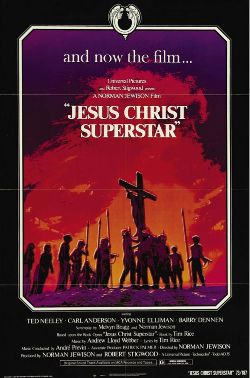On Sunday night, my family and I ended our Easter Sunday by watching Jesus Christ Superstar Live. Now, before I say anything else about NBC’s latest live musical production, there are a few things that I should make clear:
In college, there was this girl in my dorm who started the semester as a pagan, spent a month as an evangelical, and then ended the semester as a pagan again. When she was going through her evangelical phase, she would listen to the Jesus Christ Superstar soundtrack constantly, with the volume turned up so loud that you could hear it up and down the hallway. Seriously. 24 hours a day. 7 days a week. After three days, I was sick of hearing it. I found myself wondering if anyone had ever been driven to murder over having to listen to Heaven On Their Minds one too many times. Fortunately, something happened to cause her to once again lose her faith and she went back to listening to Fall Out Boy.
For quite some time afterward, I would instinctively cringe whenever I heard any of the songs from Jesus Christ Superstar. In fact, it wasn’t until I first came across the 1973 film version that I was able to once again appreciate it as a musical and overlook its association with that annoying pagan. From the first time I watched it, I really liked that movie and, every time I rewatch it, I like it even more. When I started watching Sunday’s production, I was seriously wondering if I’d be able to set aside my feelings about both the pagan and the movie and judge the television version on its own merits.
Well, I shouldn’t have worried. While I still prefer the original film version, Sunday’s television production was wonderfully conceived and executed. From the first note of music to the final curtain call, Jesus Christ Superstar Live In Concert captured my attention and refused to let it go, keeping me watching even through the lengthy commercial interruptions. The musicians and the singers sounded great, or at least they did once the audience mics were turned down. (At the start of the show, the audience was so loud that they threatened to drown out Heaven On Their Minds.) The production design was simply amazing, combining downtown New York with ancient Judea in a way that reminded us just how timeless the musical’s story truly is. (The 1973 film opened with a bunch of hippies driving through the desert. The 2018 production opened with Jesus’s name being spray painted on a wall. Both openings felt perfect for the story that was being told.)
As for the cast, Brandon Victor Dixon was compellingly intense as Judas and Norm Lewis was properly intimidating as Caiaphas. The big marquee name was Alice Cooper, who obviously enjoyed playing the production’s burlesque version of Herod. That said, the entire show was stolen by Ben Daniels, who was wonderfully conflicted as Pilate. I wasn’t as impressed by Sara Bareilles as Mary Magdalene, or I should say that I apparently wasn’t as impressed with her performance as everyone else on twitter. (To me, she seemed a bit too peppy, especially in the early numbers. I know I’m in the minority as far as that goes.) Finally, in the role of Jesus, John Legend grew on me. Of course, in the show, Jesus doesn’t really become an interesting character until he sings “Poor Jerusalem” and that was the moment that Legend himself seemed to truly feel comfortable with the role.
It’s probably pointless to compare the 1973 film to the 2018 version but still, I did find it interesting how the live version reimagined the relationship between Jesus and Judas. In the 1973 version, Jesus is largely aloof for almost the entire film. Judas seems to be frustrated because he can’t figure out what Jesus is planning to do and Jesus himself never seems to feel that he can allow himself to get truly close to anyone. In the film, Judas’s anger is the anger of someone who has spent the last few years of his life following a leader and who is now wondering if he’s been wasting his time. He’s like a Democrat who has just realized that his party is even less interested in reigning in Wall Street than the Republicans.
In the live version, the Jesus/Judas relationship came across as being a bromance gone wrong. In this version, Judas’s disatisfaction is less political and more jealousy over Jesus being closer to the Magdalene than to him. When Judas snaps at Jesus in the 2018 version, Jesus actually seems to get personally offended. The dynamic between Dixon and Legend is definitely different from the one between Ted Neeley and Carl Anderson in the original version. Of course, there’s nothing wrong with that. That’s one of the wonderful things about theater. When successfully done, each subsequent production brings something new to an old story.
Jesus Christ Superstar definitely worked. As far as the current wave of live television musicals is concerned, this was the best one yet.




